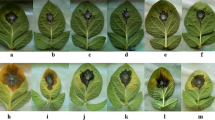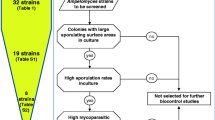Summary
Green crop lifting (GCL) for haulm killing was developed in The Netherlands and offers ideal conditions for controlling the blackleg pathogenErwinia carotovora subsp.atroseptica (Eca) by antagonists.
Based on the use of mini-tubers or young tubers from field crops, two bioassays for wound protection were developed. GCL was simulated by artificially skinning or wounding tubers, inoculating the damaged skin with Eca, treating with antagonists and incubating in either potting compost or outside in field soil.
Mainly fluorescent pseudomonads, pre-screened for in vitro antagonistic activity on agar and high soft rot reducing ability on tuber slices, were tested in the mini-tuber bioassay. Strains giving the highest degree of wound protection were further tested individually and in combination under field conditions in the young tuber bioassay. One individual strain and two combinations, resulting in reduction of contamination levels on skinned surfaces of 85% and between 60% and 70%, respectively, show good potential for biological control of blackleg.
Similar content being viewed by others
References
Bain, R.A., M.C.M. Pérombelon, L. Tsor & A. Nachmias, 1990. Blackleg development and tuber yield in relation to numbers ofErwinia carotovora subsp.atroseptica on seed potatoes.Plant Pathology 39: 125–133.
Boogert, P.H.J.F. van den, P. Kastelein & A.J.G. Luttikholt, 1994. Green-crop-harvesting, a mechanical haulm destruction method with potential for control of tuber pathogens in potato. In: T. Martin (Ed.), Seed treatment: progress and prospects. 1994 BCPC Monograph no 57, pp. 237–246.
Bouman, A., A. Mulder & L.J. Turkensteen, 1990. A green-crop-lifting method as a new system for lifting potatoes. In: Proceedings of the 11th Triennial Conference of the European Association for Potato Research, Edinburgh, pp. 386–387.
Chard, J.M., J. van Gardingen & D.C. Graham, 1992. Biological control ofErwinia diseases of potato,IOBC/WPRS Bulletin 15: 133–135.
Colyer, P.D. & M.S. Mount, 1984. Bacterization of potatoes withPseudomonas putida and its influence on postharvest soft rot diseases.Plant Disease 68: 703–706.
Delfosse, P., F. Aerts, P. Blanquet & H. Maraite, 1994. Latent infections of pectolyticErwinia spp. on seed potato tubers. In: M. Lemattre, S. Freigoun, K. Rudolph & J.G. Swings (Eds), Plant Pathogenic Bacteria. Les Colloques nr 66, ORSTOM/INRA, Paris, pp. 785–790.
Elphinstone, J.G. & M.C.M. Pérombelon, 1987. Control of contamination of potatoes with airborneErwinia carotovora by foliar application of copper oxychloride.Annals of Applied Biology 110: 535–544.
Geels, F.P. & B. Schippers, 1983. Selection of antagonistic fluorescentPseudomonas spp. and their root colonization and persistence following treatment of seed potatoes.Phytopathologisches Zeitschrift 108: 193–206.
Kastelein, P., A. Bouman, A. Mulder, E. Schepel, L.J. Turkensteen, Ph.M. de Vries & J.W.L. van Vuurde, 1994. Green-crop-harvesting and infestation of seed potato tubers withErwinia spp. and perspectives for integrated control In: M. Lemattre, S. Freigoun, K. Rudolph & J.G. Swings (Eds), Plant Pathogenic Bacteria. Les Colloques nr 66. ORSTOM/INRA. Paris, pp. 999–1004.
Kastelein, P., A. Bouman, A. Mulder, L.J. Turkensteen & J.W.L. van Vuurde, 1996. The effect of green crop lifting on the contamination of seed potato tubers by pathogenicErwinia spp.Potato Research 39: 31–42.
Kloepper, J.W., 1983. Effect of seed piece inoculation with plant growth-promoting rhizobacteria on populations ofErwinia carotovora on potato roots and in daughter tubers.Phytopathology 73: 217–219.
Mulder, A., L.J. Turkensteen & A. Bouman, 1992. Perspectives of green-crop-harvesting to control soil-borne and storage diseases of seed potatoes.Netherlands Journal of Plant Pathology 96, supplement 2: 103–114.
Patterson, H.D. & R. Thompson, 1971. Recovery of inter-block information when block sizes are unequal.Biometrika 58: 545–554.
Payne, R.W., P.W. Lane, P.G.N. Digby, S.A. Harding, P.K. Leech, G.W. Morgan, A.D. Todd, R. Thompson, G. Tunnicliffe-Wilson, S.J. Welham & R.P. White, 1993. Genstat 5 Release 3 Reference Manual. Clarendon Press, Oxford.
Pérombelon, M.C.M., 1992. Potato blackleg: epidemiology, host-pathogen interaction and control.Netherlands Journal of Plant Pathology 96, supplement 2: 135–146.
Rhodes, D.J. & C. Logan, 1986. Effects of fluorescent pseudomonads on the potato blackleg syndrome.Annals of Applied Biology 108: 511–518.
Schepel, E., A. Mulder, L.J. Turkensteen & J. Doornbos, 1996. Introduction of green crop harvesting as a haulm destruction method in seed potato production on sandy soils. In: Proceedings of the 13th Triennial Conference of the European Association for Potato Research. Veldhoven, pp. 192–193.
Turkensteen, L.J., A. Mulder & A. Bouman, 1994. Control of black scurf and other diseases of potato tubers with green-crop-harvesting and antagonistic organisms. In: G.W. Zehnder, M.L. Powelson, R.K. Jansson & K.V. Raman (Eds), Advances in potato pest biology and management. The American Phytopathological Society, St. Paul, pp. 325–331.
Vuurde, J.W.L. van & N.J.M. Roozen, 1990. Comparison of immunofluorescence colonystaining in media, selective isolation on pectate medium. ELISA and immunofluorescence cell staining for detection ofErwinia carotovora subsp.atroseptica andE. chrysanthemi in cattle manure slurry.Netherlands Journal of Plant Pathology 96: 75–89.
Vuurde, J.W.L. van & Ph.M. de Vries, 1994. Population dynamics ofErwinia carotoyora subsp.atroseptica on the surface of intact and wounded seed potatoes during storage.Journal of Applied Bacteriology 76: 568–575.
Xu, G.-W. & D.C. Gross, 1986. Field evaluations of the interactions among fluorescent pseudomonads,Erwinia carotovora, and potato yields.Phytopathology 76: 423–430.
Zielke, R., W. Ficke, K. Baganz, F. Linke, H.J. Müller, K. Naumann & K. Skadow, 1975. Die Übertragung des Erregers der Schwarzbeinigkeit und Knollennaßfäule,Pectobacterium carotovorum var.atrosepticum (van Hall) Dowson, durch Ernte- und Aufbereitungsmaschinen.Archiv für Phytopathologie und Pflanzenschutz 11: 31–41.
Author information
Authors and Affiliations
Rights and permissions
About this article
Cite this article
Kastelein, P., Schepel, E.G., Mulder, A. et al. Preliminary selection of antagonists ofErwinia carotovora subsp.atroseptica (Van Hall) Dye for application during green crop lifting of seed potato tubers. Potato Res 42, 161–171 (1999). https://doi.org/10.1007/BF02358406
Accepted:
Issue Date:
DOI: https://doi.org/10.1007/BF02358406




